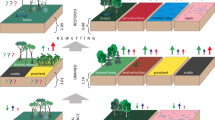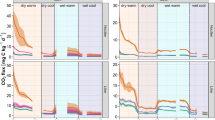Abstract
Within a long-term research project studying the biogeochemical budget of an oak-beech forest ecosystem in the eastern part of the Netherlands, the nitrogen transformations and solute fluxes were determined in order to trace the fate of atmospherically deposited NH4 + and to determine the contribution of nitrogen transformations to soil acidification.
The oak-beech forest studied received an annual input of nitrogen via throughfall and stemflow of 45 kg N ha−1 yr−1, mainly as NH4 +, whereas 8 kg N ha−1 yr−1 was taken up by the canopy. Due to the specific hydrological regime resulting in periodically occurring high groundwater levels, denitrification was found to be the dominant output flux (35 kg N ha−1 yr−1). N20 emmission rate measurements indicated that 57% of this gaseous nitrogen loss (20 kg N ha−1 yr−1) was as N2O. The forest lost an annual amount of 11 kg N ha−1 yr−1 via streamwater output, mainly as N03 −.
Despite the acid conditions, high nitrification rates were measured. Nitrification occurred mainly in the litter layer and in the organic rich part of the mineral soil and was found to be closely correlated with soil temperature. The large amount of NH4 + deposited on the forest floor via atmospheric deposition and produced by mineralization was to a large extent nitrified in the litter layer. Almost no NH4 + reached the subsurface soil horizons. The N03 − was retained, taken up or transformed mainly in the mineral soil. A small amount of N03 − (9 kg N ha−1 yr−1) was removed from the system in streamwater output. A relatively small amount of nitrogen was measured in the soil water as Dissolved Organic Nitrogen.
On the basis of these data the proton budget of the system was calculated using two different approaches. In both cases net proton production rates were high in the vegetation and in the litter layer of the forest ecosystem. Nitrogen transformations induced a net proton production rate of 2.4 kmol ha−1 yr−1 in the soil compartment.
Similar content being viewed by others
References
Bouten W (1987) Hydrological system characterization for biogeochemical research in forest ecosystems. Proc. Int. Symp. on Acidification and Water Pathways Vol. 1 UNESCO-IHP: 57–68
Bowden WB (1986) Gaseous nitrogen emissions from undisturbed terrestrial ecosystems: An assessment of their impacts on local and global nitrogen budgets. Biogeochemistry 2: 249–279
Bremner JM & Mulvaney CS (1982) Nitrogen — total. In: Page AL (Ed) Methods of Soil Analysis, Part 2. Chemical and microbiological properties. Second edition
Cole DW & Rap M (1981) Elemental cycling in forest ecosystems. In: Reichle DE (Ed) Analysis of temperate forest ecosystems. Ecological Studies. Berlin
Crutzen PJ & Ehalt DW (1977) Effects of nitrogen fertilizers and combustion on the stratospheric ozone layer. Ambio 6: 112–117
De Boer W, Tietema A, Klein Gunnewiek PJA & Laanbroek HJ (1991) The chemolithotrophic ammonium-oxidizing community in a nitrogen saturated acid forest soil in relation to pH-dependent nitrifying activity. Soil Biol. & Biochem. (in press)
Draaijers GPJ, Ivens WPMF & Bleuten W (1988) Atmospheric deposition in forest edges measured by monitoring canopy throughfall. Water, Air and Soil Pollution 42: 129–136
Duijsings JJHM, Verstraten JM & Bruynzeel LA (1983) The identification of runoff sources of a forested lowland catchment: a chemical and statistical approach. Journal of Hydrology 64: 357–375
Duijsings JJHM, Verstraten JM & Bouten W (1986a) Spatial variability in nutrient deposition under an oak-beech canopy. Zeitschrift für Pflanzenernährung und Bodenkunde 149: 718–727
Duijsings JJHM, Verstraten JM, Bruynzeel LA & Bouten W (1986b) Relationships between precipitation chemistry and some meteorological parameters in the Netherlands: a statistical evaluation. Water Air and Soil Poll. 28: 213–223
Duvignaud P & Denaeyer-de Smet S (1970) Biological cycling of minerals in temperate deciduous forests. In: Reichle DE (Ed) Analysis of Temperate Forest Ecosystems. Ecological Studies. Berlin
FAO (1974) FAO UNESCO Soil Map of the World, Vol. 1. Legend. Unesco, Paris. 59 pp
Federer CA (1983) Nitrogen mineralization and nitrification: depth variation in four New England forest soils. Soil Sci. Soc. Am. J. 47: 1008–1014
Freijer JI & Bouten W (1991) A comparison of field methods for measuring soil carbon dioxide evolution: Experiments and simulation. Plant & Soil 135: 133–142
Hutchinson GL & Mosier AR (1981) Improved soil cover method for field measurement of nitrous oxide fluxes. Soil Sci. Soc. Am. J. 45: 311–316
Kilham K (1987) A new perfusion system for the measurement and characterization of potential rates of soil nitrification. Plant & Soil 97: 267–272
Klein TM, Kreitinger JP & Alexander M (1983) Nitrate formation in acid forest soils from the Adirondacks. Soil Sci. Soc. Am. 47: 506–508
Klemedtsson L & Svensson BH (1988) Effects of acid deposition and N2O-emission from forest soils. In: Nilsson J & Grenfelt P (Eds) Critical loads for sulphur and nitrogen. Miljorapport 1988: NORD 1988: 97. Nordic Council of Ministers, Copenhagen
Kroeze C, Van Faassen HG & De Ruiter PC (1989) Potential denitrification rates in acid soils under pine forest. Neth. J. of Agric. Sci. 37: 345–354
Lang E (1986) Heterotrophe und autotrophe Nitrifikation untersucht an Bodenproben von drei Buchenstandorten. Göttinger Bodenkundliche Berichte 89: 1–199
Melillo JM (1981) Nitrogen cycling in deciduous forests. In: Clark FF & Roswall T (Eds) Terrestrial nitrogen cycles. Processes, ecosystem strategies and management impacts. Ecol. Bull. (Stockholm) 33:427–442
Moraghan JT & Buresh R (1977) Correction for dissolved nitrous oxide in nitrogen studies. Soil Sci. Soc. Am. J. 41: 1201–1202
Roelofs JGM, Kempers AJ, Houdijk ALFM & Jansen J (1985) The effect of airborne ammonium sulphate on Pinus nigra var. maritima in the Netherlands. Plant & Soil 84: 45–56
Schneider T & Bresser AHN (1988) Dutch Priority Programme on Acidification. Evaluatierapport Verzuring Nr. 00-06. RIVM, Bilthoven, The Netherlands, 190 pp
Staaf H & Berg B (1981) Plant litter input to soil. In: Clark FE & Rosswall T (Eds) Terrestrial nitrogen cycles. Ecol. Bull. (Stockholm) 33: 147–162
Stams AJM, Flameling EM & Marnette ECL (1990) The importance of autotrophic versus heterotrophic oxidation of atmospheric ammonium in forest ecosystems with acid soil. FEMS Microb. Ecology 74: 337–344
Stams AJM, Booltink HWG, Lutke-Schipholt IJ, Beemsterboer B, Woittiez JRW & Van Breemen N (1991) A field study on the fate of15N-ammonium to demonstrate nitrification of atmospheric ammonium in an acid forest soil. Biogeochemistry 13: 241–255
Stevens PA & Wannop CP (1987) Dissolved organic nitrogen and nitrate in an acid forest soil. Plant and Soil 102: 137–139
Tietema A, Duijsings JJHM, Verstraten JM & Westerveld JW (1990) Estimation of actual nitrification rates in an acid forest soil. In: Harrison AF, Ineson P & Heal OW (Eds) Nutrient Cycling in Terrestrial Ecosystems. Field methods, application and interpretation (pp 190–197). Elsevier Applied Science, London & New York
Tietema A, Bouten W & Wartenbergh PE (1991) Nitrous oxide dynamics in an oak-beech forest ecosystem in the Netherlands. Forest Ecology & Management (in press)
USDA (US Department of Agriculture) (1975) Soil taxonomy — a basic system of soil classification for making and interpreting soil survey. Agric. Handbook no 436 Soil Comm. Surv. USDA, Washington. 754 pp
Van Breemen N, Burrough PA, Velthorst EJ, Van Dobben HF, De Wit T, De Ridder TB & Reijnders HFR (1982) Acidification from atmospheric ammonium sulphate in forest canopy throughfall. Nature 299: 548–550
Van Breemen N, De Visser PAB & Van Grinsven JJM (1986) Nutrient and proton budgets in four soil-vegetation systems underlain by Pleistocene alluvial deposits. J. Geol. Soc. London 143: 659–666
Van Breemen N, Mulder J & Van Grinsven JJM (1987) Impacts of Acid Atmospheric deposition on Woodland Soils in the Netherlands. II: Nitrogen transformations. Soil Sci. Soc. Am. J. 51: 1634–1640
Van Breemen N & Van Dijk HFG (1988) Ecosystems effects of atmospheric deposition of nitrogen in the Netherlands. Environmental Pollution 54: 249–274
Van Vreenen N, Visser WJF & Pape Th (Eds) (1988) Biogeochemistry of an oakwoodland in the Netherlands affected by acid atmospheric depositions. Agric. Res. Rep. PUDOC, Wageningen, The Netherlands. 197 pp
Van Breemen N & Verstraten JM (1990) Soil acidification and nitrogen cycling: summary of research in the Dutch priority programme on acidification. In: Schneider T & Heij GJ (Eds) Thematic reports Dutch priority programme on acidification, Report nr. 200-07, RIVM, Bilthoven, The Netherlands
Van Dijk HFG, Boxman AW & Roelofs JGM (1991) Effects of a decrease in atmospheric deposition of nitrogen and sulphur on the mineral balance and vitality of a Scots Pine stand in the Netherlands. Forest Ecology and Management (in press)
Van Praag HJ, Sougnez-Remy S, Weissen F & Carletti G (1988) Root turnover in a beech and a spruce stand of the Belgian Ardennes. Plant and Soil 105: 87–103
Verstraten JM, Dopheide JCR, Duijsings JJHM, Tietema A & Bouten W (1990) The proton cycle of a deciduous forest ecosystem in the Netherlands and implications for soil acidification. Plant and Soil 127: 61–69
Vonk JW (1987) Soil acidification and microbial processes: The fate of inorganic nitrogen in acid heathland and forest soil. Report no. R 87/331. Division of Technology for Society. TNO Delft, The Netherlands
Author information
Authors and Affiliations
Rights and permissions
About this article
Cite this article
Tietema, A., Verstraten, J.M. Nitrogen cycling in an acid forest ecosystem in the Netherlands under increased atmospheric nitrogen input. Biogeochemistry 15, 21–46 (1991). https://doi.org/10.1007/BF00002807
Received:
Accepted:
Issue Date:
DOI: https://doi.org/10.1007/BF00002807




